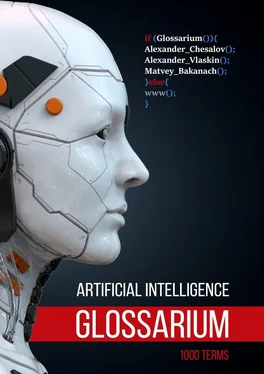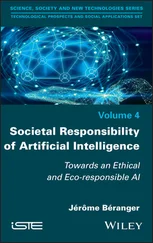Bounding Box (Ограничивающая рамка) –Commonly used in image or video tagging, this is an imaginary box drawn on visual information. The contents of the box are labeled to help a model recognize it as a distinct type of object.
Brain technology (Also self-learning know-how system) (Мозговая технология) – A technology that employs the latest findings in neuroscience. The term was first introduced by the Artificial Intelligence Laboratory in Zurich, Switzerland, in the context of the ROBOY project. Brain Technology can be employed in robots, know-how management systems and any other application with self-learning capabilities. In particular, Brain Technology applications allow the visualization of the underlying learning architecture often coined as “know-how maps”.
Brain – computer interface (BCI, Интерфейс мозг-компьютер), sometimes called a brain – machine interface (BMI), is a direct communication pathway between the brain’s electrical activity and an external device, most commonly a computer or robotic limb. Research on brain – computer interface began in the 1970s by Jacques Vidal at the University of California, Los Angeles (UCLA) under a grant from the National Science Foundation, followed by a contract from DARPA. The Vidal’s 1973 paper marks the first appearance of the expression brain – computer interface in scientific literature [ 89 89 Brain – computer interface [Электронный ресурс] //en.wikipedia.org URL: https://en.wikipedia.org/wiki/Brain%E2%80%93computer_interface (дата обращения: 07.07.2022)
].
Brain-inspired computing (Мозгоподобные вычисления) –calculations on brain-like structures, brain-like calculations using the principles of the brain (see also neurocomputing, neuromorphic engineering).
Branching factor (коэффициент ветвления дерева) –In computing, tree data structures, and game theory, the number of children at each node, the outdegree. If this value is not uniform, an average branching factor can be calculated.
Broadband (Широкополосный доступ)refers to various high-capacity transmission technologies that transmit data, voice, and video across long distances and at high speeds. Common mediums of transmission include coaxial cables, fiber optic cables, and radio waves. [ 90 90 Broadband [Электронный ресурс] www.investopedia.com URL: https://www.investopedia.com/terms/b/broadband.asp (дата обращения: 07.07.2022)
]
Brute-force search (Also exhaustive search or generate and test) (Полный перебор) – A very general problem-solving technique and algorithmic paradigm that consists of systematically enumerating all possible candidates for the solution and checking whether each candidate satisfies the problem’s statement.
Bucketing (Разделение на сегменты) –Converting a (usually continuous) feature into multiple binary features called buckets or bins, typically based on value range.
Byte (Байт)Eight bits. A byte is simply a chunk of 8 ones and zeros. For example: 01000001 is a byte. A computer often works with groups of bits rather than individual bits and the smallest group of bits that a computer usually works with is a byte. A byte is equal to one column in a file written in character format. [ 91 91 Byte [Электронный ресурс] www.umich.edu URL: https://www.icpsr.umich.edu/web/ICPSR/cms/2042#B (дата обращения: 07.07.2022)
]
Caffe –is short for Convolutional Archi- tecture for Fast Feature Embedding which is an open-source deep learning framework de- veloped in Berkeley AI Research. It supports many different deep learning architectures and GPU-based acceleration computation kernels.
Calibration layer (Калибровочный слой) –A post-prediction adjustment, typically to account for prediction bias. The adjusted predictions and probabilities should match the distribution of an observed set of labels.
Candidate generation (Генерация кандидатов) —The initial set of recommendations chosen by a recommendation system. [ 92 92 Candidate generation [Электронный ресурс] // developers.google.com URL: https://developers.google.com/machine-learning/recommendation/overview/candidate-generation (дата обращения: 10.01.2022)
].
Candidate sampling (Выборка кандидатов) —A training-time optimization in which a probability is calculated for all the positive labels, using, for example, softmax, but only for a random sample of negative labels. For example, if we have an example labeled beagle and dog candidate sampling computes the predicted probabilities and corresponding loss terms for the beagle and dog class outputs in addition to a random subset of the remaining classes (cat, lollipop, fence). The idea is that the negative classes can learn from less frequent negative reinforcement as long as positive classes always get proper positive reinforcement, and this is indeed observed empirically. The motivation for candidate sampling is a computational efficiency win from not computing predictions for all negatives.
Canonical Formats (Канонические форматы)In information technology, canonicalization is the process of making something [conform] with some specification… and is in an approved format. Canonicalization may sometimes mean generating canonical data from noncanonical data. Canonical formats are widely supported and considered to be optimal for long-term preservation. [ 93 93 Canonical Formats [Электронный ресурс] www.umich.edu URL: https://www.icpsr.umich.edu/web/ICPSR/cms/2042#C (дата обращения: 07.07.2022)
]
Capsule neural network (CapsNet) (Капсульная нейронная сеть) – A machine learning system that is a type of artificial neural network (ANN) that can be used to better model hierarchical relationships. [ 94 94 Capsule neural network [Электронный ресурс] // ru.what-this.com URL: https://ru.what-this.com/7202531/1/kapsulnaya-neyronnaya-set.html (дата обращения: 07.02.2022)
] The approach is an attempt to more closely mimic biological neural organization [ 95 95 Capsule neural network [Электронный ресурс] // neurohive.io URL: https://neurohive.io/ru/osnovy-data-science/kapsulnaja-nejronnaja-set-capsnet/ (дата обращения: 08.02.2022)
]
Case-Based Reasoning (CBR) (Рассуждения по прецедентам) –is a way to solve a new problem by using solutions to similar problems. It has been formalized to a process consisting of case retrieve, solution reuse, solution revise, and case retention [ 96 96 Case-Based Reasoning [Электронный ресурс] www.telusinternational.com URL: https://www.telusinternational.com/articles/50-beginner-ai-terms-you-should-know (дата обращения 15.01.2022)
].
Categorical data (Категориальные данные) —Features having a discrete set of possible values. For example, consider a categorical feature named house style, which has a discrete set of three possible values: Tudor, ranch, colonial. By representing house style as categorical data, the model can learn the separate impacts of Tudor, ranch, and colonial on house price. Sometimes, values in the discrete set are mutually exclusive, and only one value can be applied to a given example. For example, a car maker categorical feature would probably permit only a single value (Toyota) per example. Other times, more than one value may be applicable. A single car could be painted more than one different color, so a car color categorical feature would likely permit a single example to have multiple values (for example, red and white). Categorical features are sometimes called discrete features. Contrast with numerical data [ 97 97 Categorical data [Электронный ресурс] // machinelearningmastery.ru URL: https://www.machinelearningmastery.ru/understanding-feature-engineering-part-2-categorical-data-f54324193e63/ (дата обращения: 03.03.2022)
].
Читать дальше












